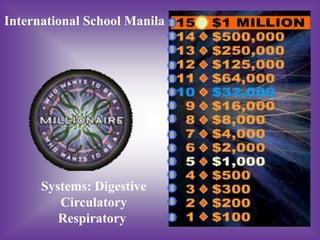
Millionaire systems 2
- 1. International School Manila Systems: Digestive Circulatory Respiratory
- 2. #1 The esophagus is A muscular tube that A: Where nutrients are B: connects the mouth absorbed and stomach C: A hollow tube with D: Not always needed cartilage rings
- 3. B
- 4. #2 The pulmonary artery sends blood to the A: Lungs B: Heart C: Small Intestines D: Brain
- 5. A
- 6. #3 Nutrients are absorbed in the A: Large Intestines B: Stomach C: Mouth D: Small Intestines
- 7. D
- 8. #4 One of the main function of the circulatory system is A: Send CO2 around the B: Carry Nutrients around body the body C: Pump oxygen around D: Both b and C the body
- 9. D
- 10. #5 Veins A: Send blood to the B: Send blood away from heart the heart C: Both a and B D: Neither A and B
- 11. A
- 12. #6 The alveoli sacs A: Are located on the B: Are in the heart trachea C: Where gas exchange D: Decrease the surface takes place area of the lungs
- 13. C
- 14. #7 The circulatory system is divided into 2 loops, why? A: Because the brain B: The body is too big for needs blood 1 loop Blood needs to be Deoxygenated blood is C: D: pumped to the lungs to sent to the heart to be receive oxygen, then to be pumped around the body pumped around the body
- 15. C
- 16. #8 Deoxygenated blood coming back to the heart enters A: The right atrium B: The left atrium C: The right ventricle D: The left ventricle
- 17. A
- 18. #9 When the diaphragm moves down it Creates Low pressure Creates High pressure A: causing air to rush in B: causing air to rush in and inflate the lungs and inflates the lungs Creates Low pressure Creates High pressure C: causing air to rush out D: causing air to rush out and and deflates the lungs deflates the lungs
- 19. A
- 20. #10 Why does the left ventricle have thicker walls than The right ventricle? Because it develops A: Because it does B: first C: It sends blood to the D: It has to pump blood lungs all around the body
- 21. D
- 22. #11 How are the respiratory and the circulatory systems linked? The circulatory system A: Nutrients need to get B: supplies blood around to the lungs and heart the body The lungs provide the O2 and allows the The blood is pumped C: blood get rid of CO2 D: back to the heart by from the body the pulmonary artery
- 23. C
- 24. #12 Why are the trachea and esophagus not built the same? The esophagus needs to A: B: push food down while the You wouldn’t want the trachea made up of cartilage so it’s flexible wind pipe to close C: They are built the D: Both A and B same
- 25. D
- 26. #13 What are 2 differences between real lungs and our models? The jar couldn’t move The diaphragm moved A: but our ribs expand B: and contract up to inflate lungs in the model C: There was no gas D: Both A and C exchange
- 27. D
- 28. #14 Arteries send blood away from the heart, veins send blood to the heart, capillaries… Are small vessels where A: Send blood to the B: nutrients and gas heart exchange take place C: Pick up CO2 from the D: Are small vessels that lungs absorb nutrients.
- 29. B
- 30. #15 Explain diffusion…. A: Picking up O2 and B: Low air pressure to leaving CO2 High Air pressure Gasses going from a Gasses going from a C: low concentration to a D: high concentration to high concentration a low concentration
- 31. D
- 32. Great Job!!!! Thank you for playing!